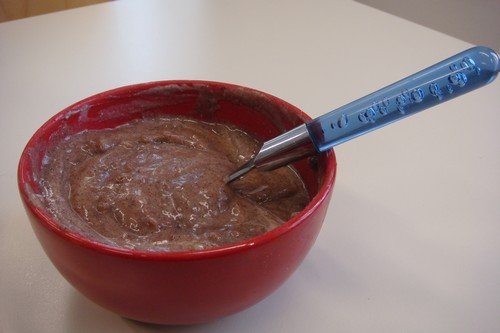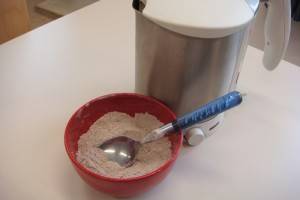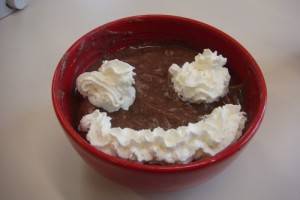
- Cuisine: East African
- Cuisine: East African
- Cuisine: East African
This recipe shows you how to make a quick mug or bowl of porridge, Uganda boarding school style, BUT NOT with a “suicide” water heater* (see below). Please note: using a mug is much more practical than the bowl in this case!
Ingredients
- 2 tablespoons millet flour ((heaped))
- 250 ml boiling water ((possibly up to 300ml - milk can be used instead!))
- sugar ((to taste))
- milk ((or whipped cream - optional))
- For: 1 serving
- Preparation: 5 min
- Cooking: 5 min
- Ready in: 10 min
Instructions
- Bring water to the boil
- Add 2 "very" heaped table spoons of millet flour to a mug holding at least 300ml (1/3 liter). I use a bowl in the illustration, but a mug is better for this method of preparation.

- Add at least a table spoon of sugar & mix well. The sugar helps in the next step.
- With one hand vigorously mixing, add water, making sure no lumps form
- Let this stand for a few minutes.
- You have just made a mug of millet porridge (commonly called "bushera", "kashera", "bush", etc), like thousands of Ugandan boarding school students do & have done every school day over many years to combat hunger at breaktime or later on in the day. Add some milk or whipped cream if you like. Some folks "moisten" the flour with water or milk, which makes the mixing smoother, with no or less lumps, but that cools down the water a bit. The sugar is then added later. You can of course make this porridge the "traditional" way if you have more than a few minutes of time or need to prepare more than a "mug" of it. Use cold water to moisten the flour and then add the hot water while stirring. Bring to the boil and cook this for a few minutes. You might need to stir a few times to avoid scorching at the bottom. You can then add milk and sugar.

Notes
There are some people who will not consider such porridge “ready” until they have boiled it for half an hour … Unless you are using unhygienically made flour, it’s not necessary to cook it that much. If it were problematic, there would be evidence of this in boarding schools where students do not have that luxury to cook (that much).
If you have the time & with a “proper” kitchen though, you can of course prepare it in a pan and cook it a few minutes, which I think is in any case better.
More about millet:
About the “suicide water heater”
For a variety of reasons, many boarding school students did not have access to gadgets like electric water kettles or something similar to quickly make a cup of tea or coffee or … “bush”, or “bushera”. Even if such a gadget was available in some dormitory, it might be that there were lots of guys who needed to quickly eat something before the 20 minute break was over & so it could not serve all. So many “enterprising” students came up with the idea of making their own “water heaters”, which are/were often referred to as “suicide” (water heater), which should give you an impression of how safe they were. One would need real “bed” springs, which would mean illegally dismantling them from beds, something that was very costly, since new heaters would be needed soon or later by different people.
The type of commonly used school beds had some springs roughly the size of a thumb, which where just the appropriate size. These springs that where “naked”, had to be connected but held apart by inserting some plastic, often broken bits of BIC or other ballpens, at the upper and lower end and had to fit in the commonly used PLASTIC mugs. The next problem was to get 2 wires from “somewhere” and carefully connect them at one end of the “heater”. It was ready for use.
So to boil water, for “bush”, you would need 2 mugs, one to boil the water, one to make the porridge. To make tea/coffee, you just needed one. With water in one mug, you carefully place the “suicide” in it & plugged in the wires at the other end. The water starts heating up as evidenced by bubbles you see forming around the springs. Some very clever guys found out that if you added some salt crystals, somehow the water would cook much faster. I do not remember my chemistry well, but I think some form of electrolysis is involved. Not too sure, because of this how pure/safe that “water” would then be.
After coming to the boil, you would carefully unplug the heater & use the water for your bush or coffee. You do not take long to learn that while the heater is “working”, you DO NOT get your hand or a spoon or anything else that conducts into the mug, because you would promptly get a memorable electrical shock. As long as the “heater” was connected, you had to handle it with care. Also, accidentally connecting the 2 “heating elements”, i.e. the springs would lead to a short circuit, which would mean lots of trouble, partly because of the additional undesirable attention.
Needless to say, because of their danger & the consequences of destruction of school beds [it was not unusual to find remains of unusable beds with just a few springs left at the beginning of the school term], there’s no school where such gadgets were legal and being caught would easily lead to severe punishment, but now and then, when hunger demanded attention … or under “appropriate conditions”, … some risks were considered inevitable.
